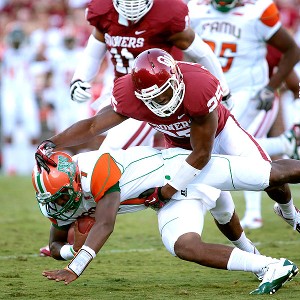Sooners backups played some against FAMU, but more time is needed to progress
Updated: September 12, 2012, 1:06 AM ET
By Brandon Chatmon | SoonerNationNORMAN, Okla. -- Alabama had six members of its 2011 defense drafted in the 2012 NFL draft, including four defenders selected among the first 35 draft picks.
And despite losing those six starters, the Crimson Tide sit atop most college football polls after two weeks of the 2012 season. Alabama has recruited well and developed depth throughout its roster, making the transition and roster turnover more seamless. While it has lost multiple starters, several of the defensive replacements had extensive playing experience to help them step in without much dropoff in 2012.

Brett Deering/Getty ImagesBackup linebacker Aaron Franklin had six tackles against Florida A&M.
The Sooners defensive ends are the perfect example. OU rotates its defensive ends, so when 2012 Big 12 defensive player of the year Frank Alexander and NFL draft pick Ronnell Lewis left the program following the 2011 season, the transition was seamless as David King and R.J. Washington were set to step right in as replacements -- before King was forced to move inside to help depth concerns at defensive tackle.
OU should strive to have the same scenario play out at every position on the roster.
Against Florida A&M, several young players got the opportunity to play, particularly when the game got out of hand. But when the Sooners' starters were in the game, OU rotated at every defensive position except safety, cornerback and linebacker.
Defensive tackles Jordan Phillips and Marquis Anderson made appearances in the second quarter with the Sooners up 21-3. It could have been an ideal time to give young linebackers Franklin Shannon and Aaron Franklin a series or a couple of snaps. Or sneak freshman cornerback Gary Simon on the field for a couple of plays to give him a feel for playing in the Sooners' No. 1 defense.
The Sooners chose to leave their starters at linebacker and cornerback in the game.
When talking about the development of Phillips and Anderson, senior defensive tackle Jamarkus McFarland explained why game experience is so critical for young players.
"In a game, it's a learning experience," he said. "If you don't have that experience of doing it, your mind can shift and go elsewhere with all the fans. Over time you grow into it, you don't need an extra voice telling you what to do, you'll start noticing things on your own."
Last season, the Sooners did a nice job of rotating along the offensive and defensive lines. That approach is the main reason guard Bronson Irwin was ready to step in when Tyler Evans was injured. And tackle Daryl Williams has seamlessly stepped into a starting role at right tackle, while defensive ends R.J. Washington, David King and Chuka Ndulue have stepped in along the defensive front despite entering the season with nine total starts (all by King) between the three of them.
Getting Shannon, Simon, Franklin and other backup defenders similar experience is crucial to limiting mental mistakes when they are thrown in the fire.
"Getting experience, that's the best way to do it," McFarland said. "You can do it in practice all day, but when those lights come on in front of 80,000 it's a whole different picture."
Safety Jesse Paulsen knows that all too well. The senior has been a special teams contributor for OU but was thrown to the wolves Saturday after starting free safety Tony Jefferson was injured. Paulsen was caught out of position on FAMU's lone touchdown. Paulsen, who otherwise played well and added three tackles, admits it was difficult to be shoved into the game alongside the starters for the first time.
"It was a surprise," Paulsen said. "I just had to calm myself down. You have to know you're going to get in there if someone goes down. I have to be more prepared next time, mentally, in case something happens."It's more mental than anything. You have to have your head in the game and be able to think."
That is much easier for a player when he's comfortable. Thinking when he's thrown into an uncomfortable situation -- like the first time on the field with the starters -- is a difficult proposition.
Against Florida A&M, OU didn't insert its No. 2 defense until midway through the third quarter, when it had a 56-10 lead. The Sooners offense rotated running backs and receivers for much of the game, particularly from the second quarter on. Yet both units could have started sprinkling in those young players during the first quarter and second quarter, after the Sooners had secured a two-touchdown lead. They weren't going to lose the game, regardless of how those young players responded. OU would have overcome any mental mistakes they made.
Oklahoma took a similar approach in 2011, leaving starters in the game deep into blowout wins over Kansas, Kansas State and Texas A&M.
Rotating players at every position could be a great move for the Sooners. It promotes competition throughout the roster, promotes focus during practice and in meetings, and, most importantly, it prepares the program for the future without sacrificing the present.
Moving forward, the Sooners might insert their younger players earlier in games as those players start to gain the trust of the coaching staff. Or they might not.
Either way, the positives of doing so are pretty clear.


No comments:
Post a Comment